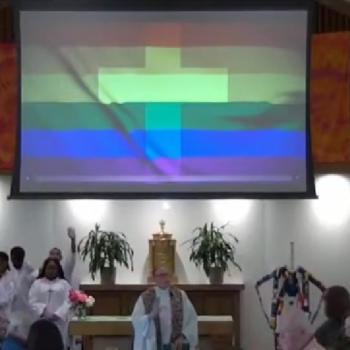First off, in a recent article, I state plainly that Fiducia Supplicans (FS) does not alter Church teaching. However, I do find problematic the use of the word “couple(s)” in an official magisterial Church document about two people of the same sex in a romantic relationship. An acknowledgement by the Church of such “couples” does reflect a subtle, yet profound, challenge to the historic view of human sexuality in Catholic moral teaching.
In fact, this official acknowledgement represents the first time same-sex “couples” are referenced as such. In previous official Church documents, the use of the word “couple(s)” reflected a specific relational reality within God’s design for human familial life. The application of this term to a relationship the document also refers to as “inadmissible,” represents a momentous shift that will be felt by the Church for years to come.
In this article, I examine official Church documents which discuss human sexuality and relationships to demonstrate that a pattern exists in the use of the word “couple(s)” and God’s intended design for human familial life. I show that, within such a pattern, this word cannot also apply to same-sex “couple(s).” (Of course, this research concerns English translations.)
GAUDIUM ET SPES (1965)
In my research, Paragraph 49 of Gaudium et Spec represents the first references the word “couple(s)” in an official Church document.
The actions within marriage by which the couple are united intimately and chastely are noble and worthy ones.
For this reason, strengthened by grace for holiness of life, the couple will painstakingly cultivate and pray for steadiness of love, large heartedness and the spirit of sacrifice.
Authentic conjugal love will be more highly prized, and wholesome public opinion created about it if Christian couples give outstanding witness to faithfulness and harmony in their love, and to their concern for educating their children also, if they do their part in bringing about the needed cultural, psychological and social renewal on behalf of marriage and the family.
Hence, while not making the other purposes of matrimony of less account, the true practice of conjugal love, and the whole meaning of the family life which results from it, have this aim: that the couple be ready with stout hearts to cooperate with the love of the Creator and the Savior. Who through them will enlarge and enrich His own family day by day.
Clearly, at the outset of the use of the word “couple(s),” the Church tied it to God’s intended design for His human family.
HUMANAE VITAE (1968)
Moreover, probably the most controversial (and highly ignored) official Church document of the 20th century, Humanea Vitae, used the word “couple(s)” thirteen times, with twelve of those uses preceded by the word “married.” The lion’s share of them occur in paragraph 26, where it states:
Among the fruits that ripen if the law of God be resolutely obeyed, the most precious is certainly this, that married couples themselves will often desire to communicate their own experience to others. Thus it comes about that in the fullness of the lay vocation will be included a novel and outstanding form of the apostolate by which, like ministering to like, married couples themselves by the leadership they offer will become apostles to other married couples. And surely among all the forms of the Christian apostolate it is hard to think of one more opportune for the present time.
This document calls on all the Catholic married faithful to follow God’s design for marriage. Therefore, it only refers to “couple(s)” as “married.”
FAMILIARIS CONSORTIO (1981)
This apostolic exhortation, on the role of the Christian family in the modern world, mentions the word “couple(s)” seventy-five times. In all cases, the word refers to married “couple(s).” Like FS, the document does refer to “irregular situations.” However, it does so cautiously. In Part Four, it states:
The Church’s pastoral concern will not be limited only to the Christian families closest at hand; it will extend its horizons in harmony with the Heart of Christ, and will show itself to be even more lively for families in general and for those families in particular which are in difficult or irregular situations. For all of them the Church will have a word of truth, goodness, understanding, hope and deep sympathy with their sometimes tragic difficulties. To all of them she will offer her disinterested help so that they can come closer to that model of a family which the Creator intended from “the beginning” and which Christ has renewed with His redeeming grace.
Here, the Church intends to help, but only so that those in such situations “come closer to the model of a family which the Creator intended.”
LETTER TO THE BISHOPS OF THE CATHOLIC CHURCH ON THE PASTORAL CARE OF HOMOSEXUAL PERSONS (1986)
The first of its kind, this letter to all the bishops of the Catholic Church from the Congregation for the Doctrine of the Faith, specifically addressed pastoral care of homosexual persons. In the almost four-thousand-word document, the word “couple(s)” does not appear even once. Regarding relationships, the document plainly states in paragraph 7:
The Church, obedient to the Lord who founded her and gave to her the sacramental life, celebrates the divine plan of the loving and live-giving union of men and women in the sacrament of marriage. It is only in the marital relationship that the use of the sexual faculty can be morally good. A person engaging in homosexual behavior therefore acts immorally.
To choose someone of the same sex for one’s sexual activity is to annul the rich symbolism and meaning, not to mention the goals, of the Creator’s sexual design. Homosexual activity is not a complementary union, able to transmit life; and so it thwarts the call to a life of that form of self-giving which the Gospel says is the essence of Christian living.
Here, the author (Cardinal Joseph Ratzinger) juxtaposes the marital union with the mere sexual activity that lacks any ability to produce life. It seems the absence of the word “couple(s)” is due to the consistent Church teaching that “couples” hold the potential to produce life. In other words, the lack of life, the absence of the word “couple(s).”
EVANGELIUM VITAE (1995)
Moreover, as with the previous documents, this one follows the same context for the word “couple(s).” In all instances the word “couple(s)” appears, the context is God’s plan for marriage. For example, in paragraph 92, it states:
As the domestic church, the family is summoned to proclaim, celebrate and serve the Gospel of life. This is a responsibility which first concerns married couples, called to be givers of life, on the basis of an ever greater awareness of the meaning of procreation as a unique event which clearly reveals that human life is a gift received in order then to be given as a gift.
Again, a different document, but the same context.
THE TRUTH AND MEANING OF HUMAN SEXUALITY (1995)
Once again, this document also uses the word “couple(s)” only in the context of God’s design for marriage. It does mention “homosexual relations” but only to reiterate established Church teaching, particularly:
For most homosexual persons, this condition constitutes a trial. “They must be accepted with respect, compassion and sensitivity. Every sign of unjust discrimination in their regard should be avoided. These persons are called to fulfil God’s will in their lives and, if they are Christians, to unite to the sacrifice of the Lord’s Cross the difficulties they may encounter from their condition”. “Homosexual persons are called to chastity”.
CONSIDERATIONS REGARDING PROPOSALS TO GIVE LEGAL RECOGNITION TO UNIONS BETWEEN HOMOSEXUAL PERSONS (2003)
Of all the documents thus far, this “consideration” from the Congregation for the Doctrine of the Faith provides a clear opportunity to re-contextualize the word “couple(s)” in the context of same-sex relationships. However, not only does this document not re-contextualize the word, but it also firmly states the reason why. In section 9, we read:
Because married couples ensure the succession of generations and are therefore eminently within the public interest, civil law grants them institutional recognition. Homosexual unions, on the other hand, do not need specific attention from the legal standpoint since they do not exercise this function for the common good.
However, the words “homosexual couples” do appear in the footnotes in reference to another document from the Pontifical Council for the Family regarding “de facto” unions. In this instance, the context (in paragraph 23) is the attempts to legalize adoption by “homosexual couples” and the dangers such a move does to the common good. This document, like all the ones before it, understands the context of “couple(s)” within its God’s given design.
Remaining Documents and Fiducia Supplicans
The remaining documents up to FS likewise fail to re-contextualize the word “couple(s).” Dignitas Personae (2008), The Vocation and Mission of the Family in the Church and in the Contemporary World: The Final Report of the Synod of Bishops to the Holy Father, Pope Francis (2015), Amoris Laetitia (2015), “Male And Female He Created Them” (2019), and in the Responsum regarding homosexual unions in 2021, the word “couples” fails to appear.
Conversely, FS departs this consistent use of the word “couple(s)” and does what no other official Church document dared do before—gives same-sex unions the official status of “couples.”
Word Matter in Official Church Documents
Now, many may wonder why someone cares so much about one simple throwaway word like “couple(s)” appearing in an official Church document about relationships of those of the same sex. They may think that since these relationships exist, same-sex couples also exist. Well, not really. Up until FS, the Church exercised great caution with this word. One could argue she did so to avoid any confusion on the part of the wider world, and more importantly, of the Catholic laity and clergy. In all other official documents, “couple(s)” carried a meaning consistent with God’s intended plan for human relationships.
The ensuing confusion surrounding FS within the Church and in the broader media reflects the wisdom of previous Church documents in not using this word for same-sex relationships. This is why an official acknowledgement by the Church (in writing) of same-sex “couple(s)” represents such a seismic shift.
Final Thoughts… Indispensable Finality
To conclude, while reviewing these documents, a passage stood out concerning those in same-sex relationships. Found it section VIII of PERSONA HUMANA(1975), we read:
In the pastoral field, these homosexuals must certainly be treated with understanding and sustained in the hope of overcoming their personal difficulties and their inability to fit into society. Their culpability will be judged with prudence. But no pastoral method can be employed which would give moral justification to these acts on the grounds that they would be consonant with the condition of such people. For according to the objective moral order, homosexual relations are acts which lack an essential and indispensable finality.
In Sacred Scripture they are condemned as a serious depravity and even presented as the sad consequence of rejecting God. This judgment of Scripture does not of course permit us to conclude that all those who suffer from this anomaly are personally responsible for it, but it does attest to the fact that homosexual acts are intrinsically disordered and can in no case be approved of. [emphasis added]
In the above paragraph, due to lacking “essential and indispensable finality,” homosexual relations do not qualify as “couple(s),” according to the objective moral order. For FS to refer to same-sex “couple(s)” proves problematic considering the above, as all other “couple(s),” even irregular opposite sex “couple(s),” do not lack “essential and indispensable finality,” as these “couple(s)” can (and do) produce life.
Therefore, while paragraph 5 in FS accurately states the Church lacks “the power to impart blessings on unions of persons of the same sex,” to many, this represents a distinction without a difference.
Those in same-sex relationships are officially “couple(s)” now and the Church can bless them as such.
Thank you!
Read The Latin Right’s other writing here.














